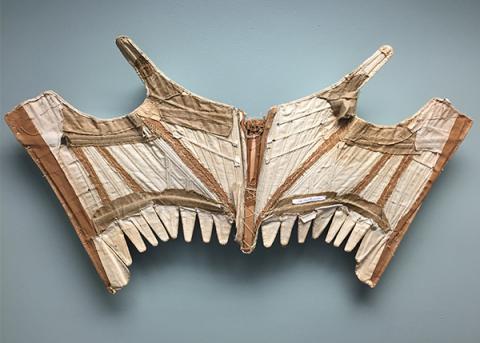Being synonymous with fashion excess and trendsetting, the contemporaries of Marie Antoinette were not always too pleased with the queen's choices. The most famous of her "shocking" creations was the flowing, sheer robe à la Reine, immortalized by Vigée le Brun. However, before she even queen, the young dauphine caused a stir on an issue that few - including both her mother and the Austrian ambassador - had expected: corsets.
The rigidly-tight whalebone corsets were a staple amongst the aristocratic ladies; its tightly-wound silhouette stands as one of the hall-marks of 18th century fashion. Yet, the newly arrived dauphine attempted to do away with the necessity of the harshest of corsets - those of whalebone. Already from an early age, the young Marie Antoinette preferred the less restricted fashion choices which were far from accepted by her contemporaries. Exceptions might have been more forthcoming had her reasons for ditching the corset been a pregnancy but that was far from the case.
Thus, shortly after arriving in France in May 1770, Marie Antoinette began refusing to don the traditional corset.
 |
| Marie Antoinette as dauphine |
The problem was the grand habit which was the required uniform for court ladies for official occasions; it is the stereotypical silhouette of the late 18th century with the wide panniers, narrow waist and heavy silks. For a 15-year old girl, the garment was immensely heavy and made even more uncomfortable by the restricting corset. In desperation, Marie Antoinette's dame d'honneur (Madame Etiquette) complained that there was "no convincing Madame la Dauphine to wear a corset".
Contemporary opinion believed that the corset was not merely a status symbol but a necessity to obtain a correct figure. In continuous attempts to make the dauphine regain the corset, one of most frequently used arguments was that her figure was already deteriorating. In an August-letter from Mercy-Argenteau to the Empress, he reported that the Comtesse de Noailles complained bitterly that the lack of a corset had rendered her charge's waist "misshapen and her right shoulder out of kilter". It was likely this missive which prompted the Empress to take personal action. As for the dauphine herself, she made no attempts at hiding the situation from her mother. She even wrote that she was growing larger around the waist as she was not wearing a corset anymore. Neither she nor Madame Etiquette appear to have taken into account that the famously slender teenager was growing in to a woman's body.
The corset - and Marie Antoinette's refusal to adopt it - was given a far greater meaning than the young girl could possibly have predicted herself. Whereas she saw it as an unnecessary and uncomfortable piece of clothing, others saw her rejection as the rejection of all things French. Immediately, such a seemingly trivial piece of "news" was spread to other European courts which had prompted the involvement of the Empress herself. The Comtesse de Noailles had attempted to get Louis XV to intervene personally but he had refused to meddle in the matter.
Reminding her daughter of her duty both towards king, husband and country (and, apparently corsets), Maria Theresia sent several Viennese corsets with her letter of admonishing from November 1770. To the Empress, this refusal was both baffling and unexpected. The Marie Antoinette she had neatly packed away in her gilded carriage was obedient and eager to please; however, the stubborn streak was beginning to show which she would retain for the rest of her life.
 |
| View of the interior of a corset, 1780 |
For the French, it was embarrassing. No lady of quality could be considered well-dressed without a corset, especially not one who held the position of first lady of the court. That the dauphine was not well-dressed was exactly what the visiting Countess Windischgrätz reported to her large acquaintance scattered across Europe. For a while there was a stalemate between a stubborn dauphine, an exasperated household and an irate mother. The end of the matter came in October 1771; its origin could be found not in the wardrobe but in the bedroom.
The arrival of the new Comtesse de Provence brought a new onslaught of complaints that the marriage between Marie Antoinette and Louis Auguste remained unconsummated. Despite being naturally slender, the constant eyes directed towards her midriff caused endless speculation of whether the dauphine had become pregnant or was "losing her figure" (at fifteen, mind you). This, in turn, kept the state of her marriage in an unpleasant spotlight which she desperately attempted to divert. Turning to the Austrian ambassador, Mercy-Argenteau for comfort, Marie Antoinette was finally convinced to wear the corset again. The much-tried ambassador reassured the Empress that there would be no fear for her figure if she continued in her improved ways.

No comments:
Post a Comment